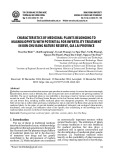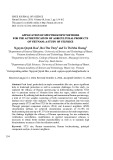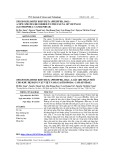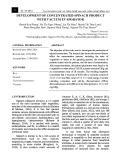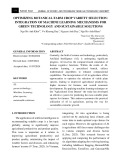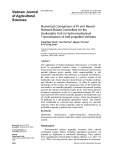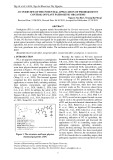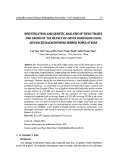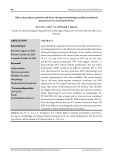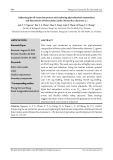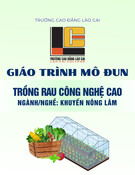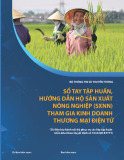
Int.J.Curr.Microbiol.App.Sci (2020) 9(4): 3125-3137
3125
Original Research Article https://doi.org/10.20546/ijcmas.2020.904.365
Identification of Maintainer and Restorer Lines for WA Cytoplasmic Male
Sterility in Rice Using Pollen Fertility and Spikelet Fertility
Vanitha1*, Jayateertha R. Diwan1, D. Shreedhara2, Vikas V. Kulkarni3,
K. Mahantashivayogayya2 and Vijaykumar N. Ghante3
1Department of Genetics and Plant Breeding, University Agricultural Sciences,
Raichur-584104, India
2Agricultural Research Station, Gangavati, University Agricultural Sciences,
Raichur-584104, India
3Main Agricultural Research Station, University Agricultural Sciences, Raichur-584104, India
*Corresponding author
A B S T R A C T
Introduction
Rice (Oryza sativa L.), a member of family
Gramineae (2n=24), is the most important
food crop of the developing world. It provides
upto two-thirds of the calories for quite pair
of billion folks in Asia and is also a major
source of protein for Asian people. Demand
for rice is anticipated to increase by about 3
per cent annually over the next decade and
beyond. In most Asian countries, prospects
for increasing rice lands are very limited,
moreover their land-to-agricultural worker
ratio is 0.27, which is lowest in the world and
International Journal of Current Microbiology and Applied Sciences
ISSN: 2319-7706 Volume 9 Number 4 (2020)
Journal homepage: http://www.ijcmas.com
Hybrid technology in many crops has contributed 20-30 per cent increase in the production
and exploitation of heterosis through the development of F1 hybrids which has been
recently deployed in rice with yield advantage of 20-25 per cent over best pure lines. The
main aim of any plant breeding programme is to develop special high yielding hybrids and
success of any plant breeding programme depends on the choice of appropriate genotypes
as parents in the hybridization programme. To accomplish this, the breeding programme
can efficiently be planned with prior knowledge of the genetic makeup of parental
genotypes whether they are sterile or complete restorer. Eighty-four rice genotypes (F1
crosses) were selected for identification of fertility restoration for five CMS lines with WA
cytoplasm. F1 crosses were analysed for pollen fertility and spikelet fertility and were
classified into four classes viz, complete maintainer, partial maintainer, partially restorer
and fully restorer. Out of 84 F1 hybrids, 13 lines were completely fertile and 5 completely
sterile. The remaining 66 hybrids expressed varying degrees of fertility (both pollen and
spikelet). Forty-nine of them were partial maintainers and the remaining seventeen were
partial restorers (based on spikelet fertility).
K e y w o r d s
Cytoplasmic Male
Sterility, Fully
Maintainer, Hybrid
rice, Partial
Maintainer
Accepted:
28 March 2020
Available Online:
10 April 2020
Article Info

Int.J.Curr.Microbiol.App.Sci (2020) 9(4): 3125-3137
3126
is declining. Land to population ratios are also
decreasing and most Asian countries must
produce more rice on less land.
In this regard, hybrid rice technology is
considered as one of the promising, practical,
sustainable, and eco-friendly options to break
the yield ceiling in rice (Virmani, 1994).
The decade of 1960s has been an eventful for
rice research and development. The semi-
dwarf rice varieties revolutionized the rice
production worldwide. In the same period
professor Yuan Long Ping acknowledged as
“Father of Hybrid Rice” pioneered research
on hybrid rice in China during 1964.
Strenuous efforts of Prof Yuan Long Ping and
his associates resulted in development and
identification of heterotic rice hybrids.
Around 15–20 per cent higher yields of
hybrid rice over best semi-dwarf inbred local
varieties, is found in many countries (FAO,
2014).
Heterosis in rice is being exploited mainly
through the utilization of male sterility
system. Although research on male sterility in
rice was first initiated in China in 1964,
heterosis in rice was not successfully
exploited until the discovery of wild abortive
male sterile cytoplasm in the wild species
Oryza rufipogon Griff. at Hainan Island in
1970. By 1973, China had the means to
develop F1 hybrids using three-line system of
hybrid rice production, which involves a male
sterile (A) line, a maintainer (B) line, and a
restorer (R) line.
The commercial exploitation of heterosis has
been attained by the use of cytoplasmic
genetic male sterility and fertility restoration
systems. Identification of sterility maintainers
and fertility restorers is ensured by estimating
the pollen fertility and spikelet fertility
percentages.
Materials and Methods
The experiment related to the identification of
sterility maintainers and fertility restorers in
rice was conducted at Agricultural Research
Station, Gangavati, University of Agricultural
Sciences, Raichur, which is situated in the
Northern Dry Zone of Karnataka between
15o_15'40" North latitude and 76o _ 31'40" East
longitude and at an altitude of 419 m above
mean sea level. The experimental material for
the present study, comprised of fifty pollen
parents having diverse genetic backgrounds,
five female lines and eighty-four experimental
hybrids derived from crosses between the
CMS lines and pollen parents. The material
was collected from Indian Institute of Rice
Research (IIRR), Hyderabad and ARS
Gangavati, UAS Raichur. A total of one
hundred and forty-three entries (five female
lines, fifty pollen parents, eighty-four hybrids
and four checks) were grown in an augmented
block design with no replication. The plot was
divided into four blocks and twenty-one
hybrids and their respective female and male
parents were sown adjacent to hybrid blocks.
Four checks were repeated in each block.
Experimental hybrids were evaluated for
pollen fertility and spikelet fertility and the
observations recorded on pollen fertility and
spikelet fertility were utilized as indices for
the identification of sterility maintainers and
fertility restorers of different cytoplasmic
male sterile lines used in the study.
Estimation of pollen fertility
At the time of flowering, panicles from three
randomly chosen plants were collected in
each of the hybrids early in the morning just
before blooming and are placed in petri plates
under moist condition. Anthers of three
randomly taken spikelets representing lower,
middle and a top portion of the panicles were
smeared in solution containing 1 % I2-KI

Int.J.Curr.Microbiol.App.Sci (2020) 9(4): 3125-3137
3127
(Iodine-Potassium Iodide) and are examined
under foldscope. A foldscope is an
optical microscope that can be assembled
from simple components, including a sheet of
paper and a lens. It was developed by Manu
Prakash and designed to cost less than US $1
to build. It provides magnification of 140X.
The kit includes magnets that can be stuck
onto the foldscope to attach it to a
smartphone, allowing the user to take pictures
of the magnification. The prepared slide is
inserted into the paper microscope and the
fertile/sterile pollens were counted and the
pictures are taken with the help of
smartphone.
The observation on pollen fertility/sterility
was recorded by counting the number of
fertile pollen grains and sterile pollen grains.
The pollens were considered to be fertile if
they were plumpy, round and deeply stained,
while they were considered as sterile if they
were shrunken, unstained and irregular in
shape. The pollens were classified based on
their shape, size and extent of staining as per
the classification given below (Virmani et al.,
1997; Chaudhary et al., 1981). Three
microscopic fields were counted for each
plant and pollen fertility was expressed in
percentage. The pollen parent of the hybrid
was classified into different categories viz.,
completely sterile, partially sterile, partially
fertile and fully fertile (Virmani et al., 1997)
(Table 1 and 2).
The numbers of fertile pollens and total
pollens were used for calculating the pollen
fertility percentage as under:
Table.1 Categories of rice pollen and their features shown as follows
Categories of pollen
Shape and staining behavior
Classification
Unstained withered
sterile (UWS)
Withered and undeveloped, unstained
Sterile
Unstained spherical
sterile (USS)
Spherical and smaller, unstained
Sterile
Stained round sterile
(SRS)
Round and small, lightly or incompletely
stained, rough surface
Sterile
Stained round fertile
(SRF)
Round and large, darkly stained, smooth
surface
Fertile
Table.2 Classification of pollen parents based on pollen fertility status of their test cross hybrids
Class
Pollen fertility (%)
Fully maintainer (FM)
0-1
Partial maintainer (PM)
1.10-50
Partial restorer (PR)
50.10-80
Fully restorer (FR)
>80

Int.J.Curr.Microbiol.App.Sci (2020) 9(4): 3125-3137
3128
Estimation of spikelet fertility
At the time of harvesting, five panicles
including one from the main culm were
harvested from randomly chosen five
different plants in each of the hybrid. The
number of filled spikelets and unfilled
spikelets were counted, after threshing the
panicles and the spikelet fertility was
expressed in percentage as the number of
filled spikelets to the total number of spikelets
(filled spikelet and unfilled spikelet). Based
on spikelet fertility, pollen parents of the
experimental hybrids were classified into four
classes (Virmani et al., 1997) as given in table
3.
Spikelet fertility percentage was calculated as
under:
Table.3 Classification of pollen parent based
on spikelet fertility percent of the
corresponding hybrids
Class
Spikelet fertility
(%)
Fully maintainer (FM)
0
Partial maintainer
(PM)
0.10 - 50.00
Partial restorer (PR)
50.10 - 75.00
Fully restorer (FR)
>75
Identification of maintainers possessing
recessive fertility restorer gene or genes and
restorers with dominant fertility restorer genes
or gene is the main step in exploitation of
hybrid vigor, and is fundamental for the
commercial exploitation of heterosis breeding
programme using cytoplasmic male sterility
(CMS) system (Rosamma and Vijayakumar,
2005; Sharma et al., 2012). Identification of
restorers and maintainers was carried out by
categorizing them based on observations
recorded on pollen fertility and spikelet
fertility percentage as per the classification
given by Virmani et al., (1997) into four
classes namely, fully maintainer, partial
maintainer, partial restorer, and fully restorer.
Results and Discussion
Experimental materials for the identification
of sterility maintainers and fertility restorers
comprised of 84 test cross progenies derived
from combinations involving 5 WA- CMS
lines and 50 pollen parents. Identification of
restorers and maintainers was carried out by
categorizing them based on observations
recorded on pollen fertility and spikelet
fertility percentage as per the classification
given by Virmani et al., (1997) into four
classes namely, fully maintainer, partial
maintainer, partial restorer, and fully restorer.
Pollen fertility restoration pattern observed in
experimental hybrids as observed under
foldscope is depicted in Figure 1.
Results showed that, F1 hybrids produced by
crossing CMS lines with selected rice
genotypes behaved differently with regard to
pollen and spikelet fertility and are presented
in the Table 4. Among 84 F1 hybrids different
levels of pollen and spikelet sterility/fertility
were observed. Such variation in pollen
fertility indicated the existence genetic
variation in respect of these reproductive
traits among the genotypes.
The pollen fertility ranged from 0.09 per cent
to 90.5 per cent, and the range of spikelet
fertility was from 0 per cent to 95.87 per cent.
The highest and lowest percentages of pollen
and spikelet fertility were found in 9A x SC5
and 7A x SC22 respectively. Similar results
were also found by Islam et al., (2015). Out
of 84 F1 hybrids having CMS lines with WA
cytoplasm, 13 lines were completely fertile

Int.J.Curr.Microbiol.App.Sci (2020) 9(4): 3125-3137
3129
and 5 completely sterile. The remaining 66
hybrids expressed varying degrees of fertility
(both pollen and spikelet). Forty-nine of them
were partial maintainers and the remaining
seventeen were partial restorers (based on
spikelet fertility). The frequencies of fully
maintainer, partial maintainer, partial restorer,
and fully restorer male lines based on pollen
fertility are 5.95, 59.50, 19.04, 15.47 per cent
respectively, and based on spikelet fertility
are 5.95, 58.32, 20.23, 15.47 per cent
respectively, as illustrated in Table 5 (based
on pollen fertility), Table 6 (based on spikelet
fertility) and graphical representation of per
cent frequency of restorers and maintainers
based on pollen fertility and spikelet fertility
is shown in Figure 2.
In the present study, among 84 F1 hybrids
raised through crossing 50 pollen parents with
5 CMS lines, the frequency of maintainers
which was found to be 64.27 per cent (5.95 %
for complete maintainers and 58.32 % for
partial maintainers) was higher than the
frequency of restorers which accounts for
35.7 per cent (20.23 % for partial restorer and
15.47 for complete restorer). Akhter et al.,
(2008) reported similar results where
frequency of maintainers (13 % complete
maintainers and 41 % partial maintainers) was
higher than that of the restorers (9 %
complete restorers and 37 % partial restorers).
The lines identified as effective maintainers
could be further backcrossed with their
respective F1‟s to look for completely sterile
backcross progenies so that, these can be
developed as new CMS lines which in turn
can be used as female parent to develop high
yielding rice hybrids. The lines identified as
complete restorers could be utilized in the
heterosis breeding (hybrid development
programme) as male parents after testing their
combining ability and heterosis.
There were instances, in which classification
of tester based on the pollen fertility did not
correlate with the classification based on the
fertility of spikelet. For example, LR31
crossed with 6A was classified as partial
restorer based on pollen fertility, and as
partial maintainer based on spikelet fertility.
SC4 behaved as partial maintainer when
crossed with 7A according to pollen fertility
percentage whereas, it is categorized under
partial restorer according to spikelet fertility
percentage. The cross 7A/TJ6 was classified
as partial restorer based on pollen fertility
percentage, and it was classified as fully
restorer based on spikelet fertility percentage.
Such lack of correlation between pollen
fertility percentage, and percentage of spikelet
fertility was reported by Murugan and
Ganesan (2006); Riaz et al., (2017); Das et
al., (2013); Joshi (2003).
In in majority of cases, it was found that
pollen fertility was higher than spikelet
fertility, but in some crosses like 10A/SC48,
9A/SC43, 8A/SC21, 7A/SC56, 6A/SC5 etc.
spikelet fertility was higher than pollen
fertility. This type of differential reaction of
pollen parents may be attributed to the ability
of single fertile pollen to fertilize a spikelet.
Therefore, even low number of fertile pollens
counted in any genotype in the study, can give
higher seed set (Joshi et al., 2003). Some of
the factors like, difference in panicle exsertion
percentage, higher angle of panicle exsertion
and some percent of outcrossing alone or in
combination have contributed for the higher
spikelet fertility than pollen fertility. It
suggests that, the pollen fertility in some
cases, is independent of spikelet fertility,
though in majority of cases there was positive
correlation between pollen fertility and
spikelet fertility percentage. Veeresha (2012)
in his study found that some of the crosses
like IR-58025A x Abhilash, IR-58025A x NP-
3-144, IR-58025A x BD-51 etc. recorded
higher spikelet fertility than pollen fertility. In
a study conducted by Kumar (2018) majority
of the crosses were in line with the results
obtained in the present study.

